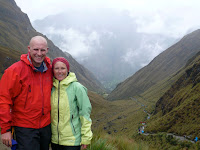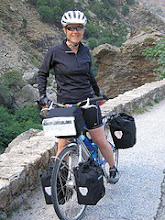 After a couple of days relaxing and taking in the sites of Arequipa (The White City) in the south of Peru, we headed off to the Colca Canyon, on Monday, with Anne-Marie and David for few days of trekking. Feeling alot better after a few days of feeling under the weather and looking forward to the prospect of both hot springs in Chivay and an 'oasis' in the canyon itself I was really excited about this trip. We were collected from our hostel early on Monday morning and headed directly out of the city, climbing high on to the Altiplano, stopping to watch the wild vicunas and herds of alpacas and llamas as the altimeter topped out at almost 4900m!
After a couple of days relaxing and taking in the sites of Arequipa (The White City) in the south of Peru, we headed off to the Colca Canyon, on Monday, with Anne-Marie and David for few days of trekking. Feeling alot better after a few days of feeling under the weather and looking forward to the prospect of both hot springs in Chivay and an 'oasis' in the canyon itself I was really excited about this trip. We were collected from our hostel early on Monday morning and headed directly out of the city, climbing high on to the Altiplano, stopping to watch the wild vicunas and herds of alpacas and llamas as the altimeter topped out at almost 4900m!From there we descended into the small town of Chivay which is the gateway to
 the Colca Canyon and attracts visitors with its hot springs located just out of town. Having missed out on the hot springs at Agua Calientes (Machu Picchu town) I was really looking forward to soaking in warm waters set in a beautiful Andean valley. The water was a lovely temperature and the view was spectacular but perhaps my expectations were a little high. I think I've been spoilt by the Thermae Spa in Bath and I found the whole thing just a little bit too dirty (perhaps not the seasoned and hardened traveller I should be by now - or maybe just a little too optimistic!). That evening we watched some local dancing and music and headed back to our hostel for a fairly early night.
the Colca Canyon and attracts visitors with its hot springs located just out of town. Having missed out on the hot springs at Agua Calientes (Machu Picchu town) I was really looking forward to soaking in warm waters set in a beautiful Andean valley. The water was a lovely temperature and the view was spectacular but perhaps my expectations were a little high. I think I've been spoilt by the Thermae Spa in Bath and I found the whole thing just a little bit too dirty (perhaps not the seasoned and hardened traveller I should be by now - or maybe just a little too optimistic!). That evening we watched some local dancing and music and headed back to our hostel for a fairly early night.An early breakfast the next morning set us up for drive to 'Cruz del Condor' where (you guessed it) we were supposed to watch the magnificent condors soaring on the thermals that rise out of the Colca Canyon (the second deepest in the world). Unfortunately thick cloud sat stubbornly in the canyon
 obscuring any view that we may have had and we had to leave the viewpoint without a sighting. It was here that we met our trekking guide, Remi. Together we boarded a local bus and rode for about 20 minutes to get to the start of the trek. This first day was almost all downhill into the base of the spectacular canyon, second only in depth to another Peruvian but more remote canyon further to the east. The enormity of Colca can be seen in the photo above taken by Simon that shows us on the path that winds around the canyon side. After reaching the river in the base of the canyon we crossed a bridge and ascended to the small village of San Juan where our guide used a local family's kitchen to cook us our lunch. Refueled and enjoying some seriously hot sunshine (the temperature in the canyon regularly reaches 35 degrees) we set off on an undulating trek to the enticingly titled 'Oasis' where we were to spend the night. This part of the trek saw some steep ascending, river crossing and finally a long down hill section giving us the opportunity to glimpse the oasis from a height.
obscuring any view that we may have had and we had to leave the viewpoint without a sighting. It was here that we met our trekking guide, Remi. Together we boarded a local bus and rode for about 20 minutes to get to the start of the trek. This first day was almost all downhill into the base of the spectacular canyon, second only in depth to another Peruvian but more remote canyon further to the east. The enormity of Colca can be seen in the photo above taken by Simon that shows us on the path that winds around the canyon side. After reaching the river in the base of the canyon we crossed a bridge and ascended to the small village of San Juan where our guide used a local family's kitchen to cook us our lunch. Refueled and enjoying some seriously hot sunshine (the temperature in the canyon regularly reaches 35 degrees) we set off on an undulating trek to the enticingly titled 'Oasis' where we were to spend the night. This part of the trek saw some steep ascending, river crossing and finally a long down hill section giving us the opportunity to glimpse the oasis from a height.A final bridge led to the 'rustic bungalows' where we were to spend the night. Again, my initial optimistic ideas about what these bungalows might look like were quickly redefined as we got closer to the 'oasis'. The circular buildings made out of bamboo (see the picture at the top) with dirt floors and bamboo beds were certainly rustic - but perhaps a little more rustic than I was expecting! However, the beds were comfortable and at shortly after 7pm, having eaten a dinner (again prepared by our guide - a little more basic than we've become accustomed to since our trek to Machu Picchu...) and with no electricity, we headed to bed: we had a ridiculously early alarm call the next morning.
At 1.50am Remi called vamos (let's go) through the bamboo walls - I must admit to already being wide awake, having slept very little for fear of creepy crawlies and other nasties making their way through the gaping bamboo and into my bed. At 2am sharp we set off on what was to be a 4 hour climb out of the steep sided canyon. There was definitely a feeling of triumph at evenutally reaching the top as the sun was rising, but I can't admit to enjoying the experience. I know that had I climbed in daylight it would have been blisteringly hot and we would have missed our bus back, however...it is not normal to be trekking uphill in the dark in the middle of the night and it was perhaps the first time that I have really longed for my own bed.

Back in Arequipa and fully rested I can look back on my Colca Canyon experience and feel pleased that I did it. The canyon is beautiful and the trip was certainly worthwhile...I'm just glad that I can leave my hiking boots off for a while and enjoy sightseeing in daylight hours!
Tomorrow we head by bus to Tacna (in the far south of Peru) and then by collectivo taxi over the Chilean border to Arica. This will be our last evening in Peru and we're going out to treat ourselves to a good meal and a glass of wine. This is an amazing country of which I feel we've only scratched the surface: so rich in history and culture set within spectacular landscapes.




















